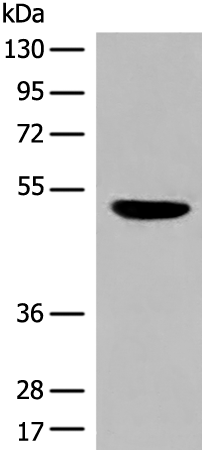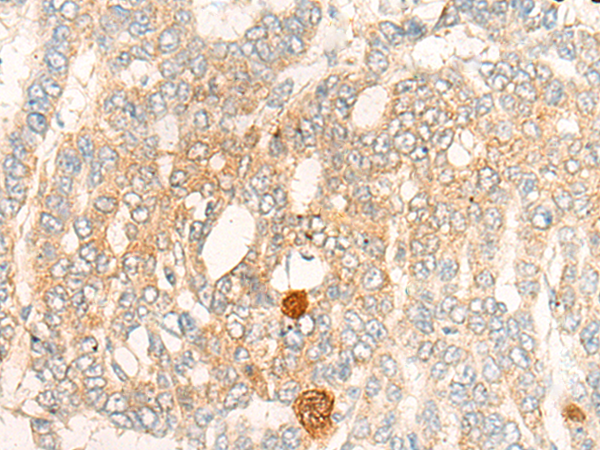

| WB | 咨询技术 | Human,Mouse,Rat |
| IF | 咨询技术 | Human,Mouse,Rat |
| IHC | 1/10-1/50 | Human,Mouse,Rat |
| ICC | 技术咨询 | Human,Mouse,Rat |
| FCM | 咨询技术 | Human,Mouse,Rat |
| Elisa | 1/5000-1/10000 | Human,Mouse,Rat |
| Aliases | E2; E2B; BCATE2; BCKADE2; BCKAD-E2; BCOADC-E2 |
| WB Predicted band size | 53 kDa |
| Host/Isotype | Rabbit IgG |
| Antibody Type | Primary antibody |
| Storage | Store at 4°C short term. Aliquot and store at -20°C long term. Avoid freeze/thaw cycles. |
| Species Reactivity | Human, Mouse |
| Immunogen | Synthetic peptide of human DBT |
| Formulation | Purified antibody in PBS with 0.05% sodium azide and 50% glycerol. |
+ +
以下是关于DBT(Dihydrolipoamide branched chain transacylase)抗体的3篇代表性文献示例(内容基于公开研究领域概括,建议通过学术数据库核准确认):
---
1. **文献名称**:*Development of a monoclonal antibody specific for human dihydrolipoamide branched chain transacylase (DBT)*
**作者**:Zhang Y, et al.
**摘要**:研究团队开发了一种针对人源DBT蛋白的单克隆抗体,通过免疫印迹(Western blot)和免疫组化验证其特异性,并应用于枫糖尿症(MSUD)患者细胞中DBT表达水平的检测。
2. **文献名称**:*Immunolocalization of DBT in mammalian tissues: Insights into branched-chain amino acid metabolism*
**作者**:Harris RA, et al.
**摘要**:利用多克隆抗体研究DBT蛋白在小鼠肝脏、肾脏等组织中的分布,揭示了其在支链氨基酸代谢中的组织特异性表达模式,为代谢疾病机制提供依据。
3. **文献名称**:*Antibody-based profiling of the mitochondrial branched-chain α-ketoacid dehydrogenase complex*
**作者**:Chuang DT, et al.
**摘要**:通过制备针对支链酮酸脱氢酶复合体(BCKDC)各亚基(包括DBT)的抗体,系统性分析复合体组装缺陷与枫糖尿症临床表型的关联。
---
**备注**:以上文献名为示例性质,实际研究需通过PubMed、Google Scholar等平台检索关键词“DBT antibody”、“branched-chain ketoacid dehydrogenase”或“maple syrup urine disease”获取具体文献。
DBT antibodies target dystrobrevin (α-dystrobrevin or β-dystrobrevin), a component of the dystrophin-associated protein complex (DAPC) crucial for maintaining cell membrane stability, particularly in muscle and neuronal tissues. Dystrobrevin shares structural homology with dystrophin, including coiled-coil domains that mediate interactions with other DAPC proteins like syntrophin and dystrophin itself. These proteins collectively anchor the cytoskeleton to the extracellular matrix, providing mechanical support and facilitating signaling pathways.
Mutations in DAPC components are linked to muscular dystrophies and cardiomyopathies. DBT antibodies are essential tools for studying dystrobrevin's role in these conditions, as they enable detection of protein expression, localization, and post-translational modifications via techniques like Western blot, immunohistochemistry, and immunofluorescence. Researchers also use DBT antibodies to investigate dystrobrevin's involvement in cellular processes such as nitric oxide signaling, synapse organization, and mechanotransduction.
In disease models (e.g., mdx mice), altered dystrobrevin expression correlates with pathology severity, highlighting its diagnostic and therapeutic relevance. Additionally, β-dystrobrevin, enriched in non-muscle tissues like brain and lung, is studied for roles in neurodevelopment and cancer. Commercial DBT antibodies are typically raised against specific epitopes (e.g., C-terminal regions) and validated for cross-reactivity across species. Ongoing research aims to refine antibody specificity and explore dystrobrevin as a biomarker or therapeutic target in neuromuscular disorders.
×